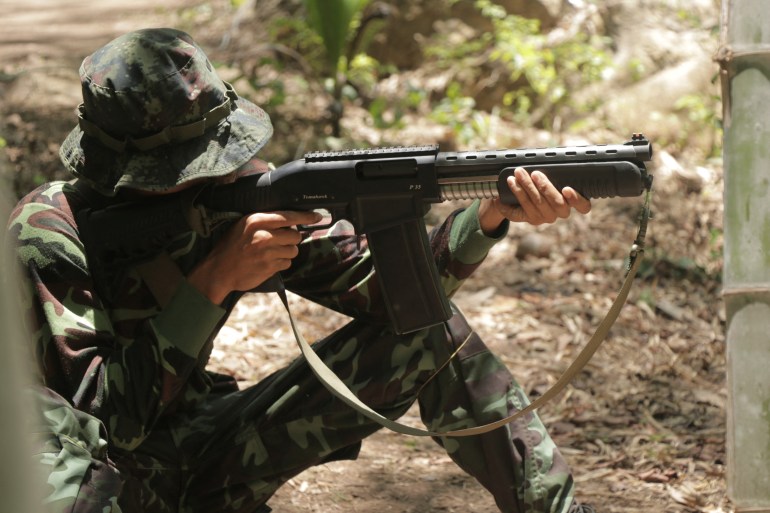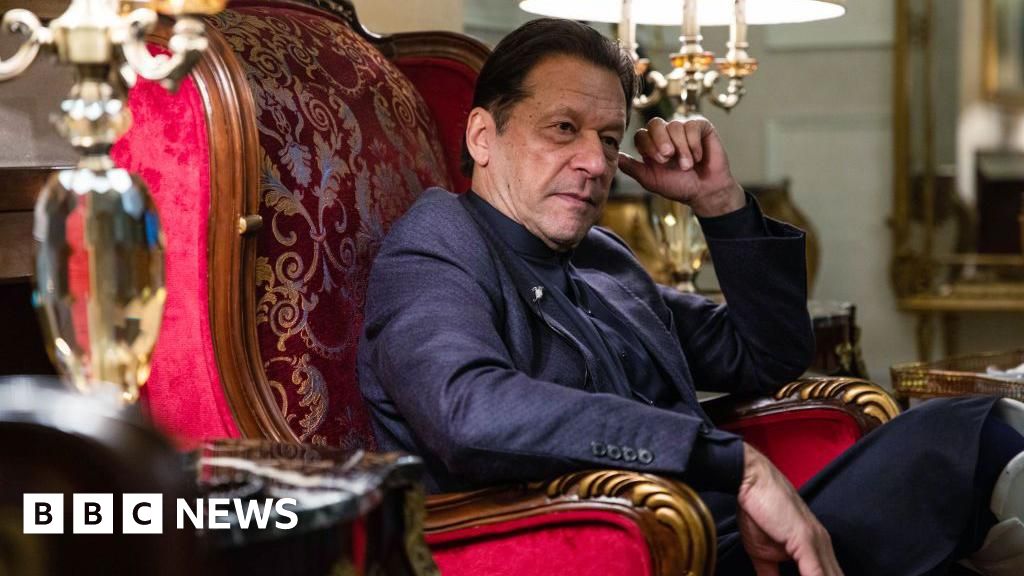Myanmar’s rebels see unity as key to victory over weakened military rulers | Conflict News
Karen State, Myanmar – A young fighter looks out from the upper floor in a concrete skeleton of a church that villagers have been building for two years in this small pocket of southeast Myanmar.
The construction work has been a slow undertaking, said 21-year-old Zayar, a member of Myanmar’s Muslim community who moved from the country’s biggest city, Yangon, to this rebel camp near the Thai border to fight against his country’s military rulers.
Air strikes by military warplanes are a constant threat in this hamlet in Karen State – also known as Kayin – where jobs are scarce and money is tight.
But, little by little, the ethnic Karen here were able to build their church.
“Before, we thought the Karen people were dacoits [bandits],” said Zayar, who joined the rebellion against Myanmar’s military just last year.
“Now people understand the real situation,” he told Al Jazeera.
Zayar’s opinion of the Karen – one of Myanmar’s largest minorities – was shaped by disparaging depictions and stereotypes circulated under the country’s military generals, who primarily hail from the ethnic Bamar majority and have violently suppressed the aspirations of Myanmar’s diverse ethnic groups for decades.
The Myanmar military’s attempts to pressure the country’s minorities into submission – stretching as far back as the 1940s – fuelled one of the longest-running conflicts in the world.
Now as military leaders mark their third year since seizing power in Myanmar, an uprising that melds the decades-old ethnic struggles for self-determination with the more recent armed fight to restore democracy has enveloped much of the nation.
In October, the Myanmar National Democratic Alliance Army (MNDAA), based in the Mandarin-speaking region of Kokang on the border with China, along with two other powerful ethnic armed groups, as well as Bamar fighters, launched their offensive against the military.
The collaboration – known as the Three Brotherhood Alliance – has scored unprecedented victories against Myanmar’s military, which toppled Aung San Suu Kyi’s civilian government in February 2021.
Resistance to the country’s military rulers is now a broad church and confidence in the movement and its campaign has been massively boosted by the participation of a growing number of armed actors.
However, the alliance’s common cause of removing the military from power remains set against a complex history of rivalries and suspicions between a multitude of ethnic armed groups – divisions which the military has successfully exploited to its benefit in the past.
As the alliance’s offensive moves from the countryside to urban areas in the west, north and east of Myanmar, the military is struggling to find a way back, and some fear the collaboration among the rebels will not hold together.
Unity of purpose
Zayar slings his rifle around his shoulder and takes the path past corn and peanut crops to his camp. His role in the revolution embodies much of the dreams and contradictions that have come to define the struggle in Myanmar.
On a friend’s recommendation, Zayar joined the Kawthoolei Army (KTLA), a fringe splinter group formed by General Ner Dah Bo Mya, who stormed out of the established Karen National Union (KNU) armed movement after refusing to participate in an investigation into the killing of a group of men allegedly carried out by his fighters in 2021.

Ner Dah Bo Mya has not denied the killings were carried out by his fighters, claiming the 25 unarmed men were military spies.
He has also cultivated a firebrand image for his KTLA unit that has attracted young people itching to take up weapons to overthrow the military dictatorship.
Though both are fighting the military, the KTLA has also clashed with the KNU in southern Myanmar. On other occasions, KTLA fighters and soldiers under KNU command have worked together on operations.
![KTLA fighters stand to attention at their base in Karen State, Myanmar, in December [Lorcan Lovett/Al Jazeera]](https://www.aljazeera.com/wp-content/uploads/2024/02/IMG_6078-1706770659.jpeg?w=770&resize=770%2C545)
Unity, says Myanmar political analyst Kim Jolliffe, stands as the overriding factor in the success of the current armed revolt.
Being unified is not only necessary for military success, said Jolliffe, but also for laying the foundation of a post-military Myanmar.
Unity, he said, will be key to moving the country away from a “highly coercive centralised state” that “creates perpetual conflict” to one where “all ethnic groups are equal in a genuine power-sharing mechanism”.
“The central problem that the revolution must solve is how to create a system that enhances the diversity and create a power balance so that no single group positions themselves as overarching chauvinist controllers,” Jolliffee told Al Jazeera.
“We will likely continue to see localised conflicts and tensions among resistance groups in some areas. But there is little to suggest that it will have a fundamental impact on the overall direction of the revolution,” he added.
While some ethnic forces have aligned with the military or have remained neutral, most of the country’s formidable ethnic armed groups have poured their resources and troops into the current campaign against the generals.
Zayar said he has risked everything for the revolution.
“Living under the dictatorship is worse than death,” he says. “I will fight back until I die.”
For Zayar, he is fighting for equality.
Being of the Muslim faith in predominately Buddhist Myanmar, some have called him a “kalar” – a term used as a slur against Muslims or anyone of South Asian origin in Myanmar. His official Myanmar national identity card also marks him out as a “Muslim”, not only as his religion but also as an ethnic identity, he says.
“When the government put me as that, I felt discriminated,” he told Al Jazeera.
“I was born and raised in Myanmar. Of course, I’m Myanmar.”
![Two KTLA troops dress in clothing donated by supporters perform a comedy dance routine to the amusement of their comrades at their camp [Lorcan Lovett/Al Jazeera]](https://www.aljazeera.com/wp-content/uploads/2024/02/IMG_6007-1706771357.jpg?w=770&resize=770%2C513)
Zayar joined the revolution relatively late – in April 2023 – more than two years after the military’s chief commander Min Aung Hlaing seized power from Aung San Suu Kyi.
On the military’s side, people are unwilling to fight for coup leader Min Aung Hlaing, who has overseen an unceasing chain of atrocities against civilians across the country since seizing power.
News outlets such as Frontier Myanmar and Radio Free Asia have reported the military snatching young men off the streets at night and threatening to burn down villages as a way to secure recruits and boost their numbers.
Due to the military’s postcoup violence driving peaceful protesters to seek combat training under the guidance of ethnic rebels, the regime’s once inexperienced opponents have developed into battle-hardened fighters.
Troop movements by the military have become rarer. Mostly it relies on air strikes and heavy weaponry from fortified positions. Mass surrenders by regime troops have reinforced notions of sinking morale among the rank and file.
Discontent within the military at Min Aung Hlaing’s leadership has also stirred persistent rumours that the coup leader may be overthrown himself by his comrades in arms.
In the opposing camp, fighters such as Zayar understand the importance of maintaining unity with other groups in the fight to free Myanmar from military rule.
But there is a paradox in Zayar and others joining splinter armed groups, such as the KTLA, which could in the long run lead to disunity in the war against the military regime.
Division and diversity
Zayar’s commander, Lar Phoe, 30, points towards a plume of smoke rising from a hillside. The military had burned and abandoned their own outpost two days previous, he said.
“If they didn’t, they may not have got the chance to retreat again,” Phoe, heavy-set and hobbling in a sleeveless traditional Karen tunic, told Al Jazeera.
Injured by a blast from a mortal shell that hit his ankle a year ago was a bookmark in his service to the Karen cause, which began as a child in a refugee camp where he would emulate those he once called “the big soldiers”.
![A commander with the KTLA Lar Phoe in Karen State in December 2023 [Lorcan Lovett/Al Jazeera]](https://www.aljazeera.com/wp-content/uploads/2024/02/IMG_6065-1706770872.jpg?w=770&resize=770%2C513)
Phoe continues to lead Karen fighters on the front line. He had returned only the week before from a two-day ambush on a military column.
He tells how military reinforcement had dressed as farmers and hide their guns in bags used for corn cobs. Mistaking them for civilians, Phoe’s unit of KTLA fighters allowed them to pass, only to be surprised with a sputter of gunfire.
“We lost some fighters and sustained injuries,” he said. “The junta soldiers know we care about locals, so they take advantage of that.”
Under Phoe’s command are about 70 men and four women of mixed ethnicities. Many are from the cities. Wielding a mix of rifles and semiautomatic guns, they form a line and salute every time a car enters the camp.
“I never imagined a situation in which Bamar, and other ethnic people, would be under my command,” he said, reflecting on the disunity of the Karen and hoping the KTLA and KNU could be “united as one”.
“The nature of revolution is unity,” he said. “It is the path to work as one. If the leaders are united, the rest of the forces would unite.”
It was a calling for unity against the military that drew Phue Phue, 28, a female Bamar fighters, back to her native Myanmar for the first time since she was 15.
Phue recounted how she moved to Thailand to work in a paper factory as a teenager and how a KTLA recruitment video on TikTok drew her home and into armed rebellion.
![Phue Phue joined the KTLA against their wishes of her mother [Lorcan Lovett/Al Jazeera]](https://www.aljazeera.com/wp-content/uploads/2024/02/IMG_6058-1706771027.jpg?w=770&resize=770%2C513)
Sitting in a hammock, in a Guns N’ Roses T-shirt, she tells how the Karen have shared their food and shelter with her, an ethnic Bamar, “so we can continue our revolution”.
“They take care of us for everything,” she said.
Phue also spoke of the arguments she had with her mother, who tried to pour cold water on the idea of her daughter joining an armed group to fight the military.
Phue’s mother asked her if she would be willing to kill her own relatives who serve in Myanmar’s military if they were to meet in battle.
“I said ‘yes, if I’m faster than them’,” Phue said.
“My mum was really angry, but it helped her realise how important this revolution is,” she said.
About a year ago, Phue told her mother she was going to get her hair cut.
“Then I ran away,” she said.
Since joining the KTLA she has stopped talking with her family.
“I can’t handle the feeling of missing my mum so much. I can’t bear the heart break of her crying,” Phue said, becoming tearful as she spoke to Al Jazeera.
“When the revolution is over, I will go back home,” she added.
Check out our Latest News and Follow us at Facebook
Original Source







